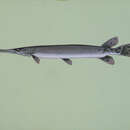pt-BR
nomes no trilho de navegação


Perception Channels: tactile ; chemical
Since shortnose gar and other gar species compete with popular gamefishes, they are regarded as a nuisance to many sport fishermen. There are some gar fishing enthusiasts, but their popularity as a sport fish is low. Their perceived lack of value has prompted many actions to eliminate them from some aquatic areas. A related species, the alligator gar Atractosteus spatula, is under intense pressure in some parts of the southern United States (Eddy, 1974).
US Federal List: no special status
CITES: no special status
Shortnose gars may be smaller than 9-10 mm long when they hatch. Although capable of swimming, they use an adhesive structure to hang vertically by their snout from objects in the water, and they will commonly attach to surface film. After exhausting the yolk sac, the fry become more active and assume a horizontal attitude. The fry usually remain near area of egg deposition (Echelle and Riggs, 1972).
Fishermen have an aversion to the shortnose gar because of their competitive predatory habits and lack of value as a sport fish. Often fishermen attempt to capture them for purposes of removal. Fortunately for the shortnose gar, their slender shape and behavior make them difficult to capture in siene nets (Eddy, 1974).
The shortnose gar are predators that can occupy the role of a scavenger, but often competes for food with common gamefishes like the northern pike, walleyes, and bass. However, they often thrive in waters not suitable for game fishes (Eddy, 1974).
Young of the year gars consume a variety of food items, ranging from tiny crustaceans to different life stages of insects and fish. The diet of young gars suggests that most feeding is surface oriented. Adult and young of the year gars feed more actively at night than during the day (Echelle and Riggs, 1972).
Hunting activity of gars can be described as stalking rather than active pursuit. Gars are typically opportunist, consuming the most available food. Shortnose gar consume more invertebrates than any other species of gar (Vokoun, 2000).
Gars are efficient ambush predators (Moyle and Cech, 1988). With its long jaws, gars lie in ambush and catch fish with a sideways strike (Bone, 1999).
Animal Foods: fish; insects; zooplankton
Primary Diet: carnivore (Piscivore , Insectivore , Eats non-insect arthropods)
The shortnosed gar is found in Mississippi River basin from south central Ohio, northern Indiana and Wisconsin to Montana and south to Alabama and Louisiana (Page and Burr, 1991). The species is also found in Lake Michigan drainage in Wisconsin. Shortnose gar presumably dispersed into Wisconsin from the Mississippi river via the Wisconsin and Fox rivers (Priegel, 1963).
Biogeographic Regions: nearctic (Native )
Habitat of the shortnosed gar includes lakes, swamps, and the calm pools and backwaters of creeks and rivers. They are commonly found near vegetation and submerged logs.
Habitat Regions: temperate
Aquatic Biomes: lakes and ponds; rivers and streams
Wetlands: swamp
Average lifespan
Status: captivity: 20.0 years.
Gar species in North America are easily recognized by their long snouts, sharply toothed jaws, non-overlapping and diamond shaped ganoid scales, and posterior placement of dorsal and anal fins on the body. Specifically, the shortnose gar is characterized by a short (relative to other gars), broad snout. The upper jaw is longer then the rest of the head and contains only one row of teeth. The shortnose gar has olive or brown coloration with white on the ventral side and black spots on median fins. Paired fins usually lack spots (spots found only on individuals living in clear water). Juveniles have fairly broad dark brown stripes along back and side.
Range length: 83 (high) cm.
Other Physical Features: ectothermic ; bilateral symmetry
Average mass: 1430 g.
Due to gars bony composition and tough, interlocking ganiod scales, gars are nearly impervious to any forms of predation. Adult gars have no known predators except humans.
Known Predators:
Gars begin to spawn in early to mid April until the end of May (Eschelle and Burr, 1972). Shortnose gars spawn in shallow water among the grass and aquatic weeds and prefer grassy sloughs as spawning grounds. Their eggs are large, green, and poisonous to warm-blooded vertebrates, including humans (Eddy, 1974).
Breeding season: early to mid April until the end of May
Key Reproductive Features: iteroparous ; seasonal breeding ; sexual ; fertilization (External ); oviparous
Shortnose gar do not care for their young.
Parental Investment: no parental involvement